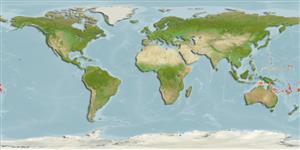>
Gobiiformes (Gobies) >
Gobiidae (Gobies) > Gobiinae
Etymology: Trimma: Greek, trimma, -atos = something crushed (Ref. 45335); anthrenum: From the Greek word 'anthrene', a wild bee, wasp or hornet, referring to its aposematic coloration of yellow with black stripes..
More on author: Winterbottom.
Environment: milieu / climate zone / depth range / distribution range
Ecologia
marinhas associadas(os) a recifes; intervalo de profundidade 5 - 76 m (Ref. 57544). Tropical
Western Pacific: Fiji and Tonga.
Tamanho / Peso / Idade
Maturity: Lm ? range ? - ? cm
Max length : 2.0 cm SL macho/indeterminado; (Ref. 57544); 2.0 cm SL (female)
Espinhos dorsais (total): 7; Raios dorsais moles (total): 8-9; Espinhos anais 1; Raios anais moles: 7 - 9. Diagnosis: Characterized by the presence of scales in the predorsal midline; second and third dorsal spines either slightly or not elongate; an unbranched fifth pelvic fin ray; both interorbital and postorbital trenches moderately well developed; and the absence of opercular scales. Scale margins of preserved specimens are very finely outlined with melanophores across the top half of the body, which is otherwise almost devoid of visible pigment cells. When alive, it has a yellow body, and the iris has a pair of blue and black triangles with their bases against the anterior and posterior margins of the pupil (giving the pupil a slit-like appearance), the posterior triangle continues anteroventrally around the pupil margin. Both living and preserved specimens have a dark basal stripe in the medial fins and a blaze of brown pigment on the upper part of the pectoral-fin base (Ref. 57544).
Life cycle and mating behavior
Maturidade | Reprodução | Desova | Ovos | Fecundidade | Larvas
Winterbottom, R., 2006. Two new species of the gobiid fish Trimma from the coral reefs of the western Pacific Ocean (Pisces; Perciformes; Gobioidei). Zootaxa 1331:55-68. (Ref. 57544)
Categoria na Lista Vermelha da IUCN (Ref. 130435)
Ameaça para o homem
Harmless
Utilização humana
Mais informação
Nomes comunsSinónimosMetabolismoPredadoresEcotoxicologiaReproduçãoMaturidadeDesovaAgregação para desovaFecundidadeOvosDesenvolvimento dos ovos
Idade/TamanhoCrescimentoComprimento-pesoComprimento-comprimentoFrequência de comprimentoMorfometriaMorfologiaLarvasDinâmica larvarRecrutamentoAbundânciaBRUVS
ReferênciasAquaculturaPerfil para aquaculturaEstirpesGenéticaElectrophoresesHereditariedadeDoençasProcessamentoNutrientsMass conversion
ColaboradoresFotografiasStamps, Coins Misc.SonsCiguateraVelocidadeTipo de nataçãoÁrea branquialOutras referênciasCérebrosVisão
Ferramentas
Relatórios especiais
Descarregue XML
Fontes da internet
Estimates based on models
Preferred temperature (Ref.
123201): 25.4 - 28.7, mean 27.3 °C (based on 124 cells).
Phylogenetic diversity index (Ref.
82804): PD
50 = 0.5000 [Uniqueness, from 0.5 = low to 2.0 = high].
Bayesian length-weight: a=0.01023 (0.00477 - 0.02194), b=3.02 (2.84 - 3.20), in cm total length, based on LWR estimates for this (Sub)family-body shape (Ref.
93245).
Resiliência (Ref.
120179): Elevada, tempo mínimo de duplicação da população menor que 15 meses (Preliminary K or Fecundity.).
Fishing Vulnerability (Ref.
59153): Low vulnerability (10 of 100).
